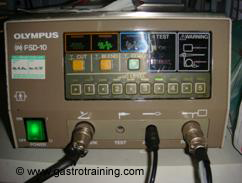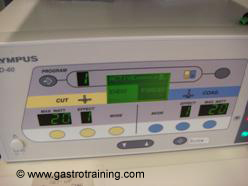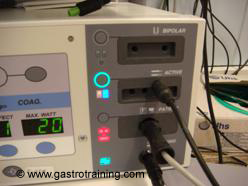Diathermy and ERBE
The module covers:
- How to set up diathermy
- Common uses and current settings
- The principle of diathermy- cutting and coagulation current
- Use of Diathermy in patients with pacemakers/ICDs
Picture1: The ERBE diathermy box ( ICC 200)![]()
How it is set up
- Put the patient electrode and connect to the neutral on the box ( ERBE ICC 200)
- Connect the active electrode cable to the accessory eg snare ( Active electrode comes from the middle socket of the diathermy unit – which says cut/coag)
- Switch on the machine- the light will be green if circuit is ok
- Select the diathermy setting
- Decide what you are going to use- Cutting or coagulation
- Effect- by repeatedly pressing the effect select button ( bottom button which looks like a loop with an arrow)
- Watt- by repeatedly pressing the watt select button ( middle up/down button ).
- Activate by pressing the foot pedal- blue for the coagulation and yellow for the cutting current.
Common use and current settings
- Remember you need to attach the patient electrode for all the procedures detialed below except the gold probe.
- For colonic polypectomy: See Picture
- Precondition first with coagulation current – Choose Autocoag to Forced, power to 15-30W and use blue foot pedal – quick short bursts –two or three times- the tissue will blanch
- Follow it with Cutting current – Choose Autocut to Effect 3, Power 200W, Endocut on and use yellow foot pedal- longer bursts and continue until it cuts through the stalk of the polyp.
- ERBE recommends the above, however a lot of colonoscopists prefer to keep the Autocut power 150W. For the Autocoagulation ( the preconditioning before the actual cut to minimize the chance of bleeding) choose 15-20W for right colon and 25-30W for left and transverse colon polyp.
- Remember some might do the entire procedure only with coagulation current and some only with cutting current
ERBE settings in the use of polypectomy
- For hot biopsy:
- Do not use cutting current at all. For best results ( so far as preserving the pathology is concerned) set Auto-coagulation to Soft, power to 60-70W and use blue foot pedal.
- More frequently people use Auto-coagulaton to Forced, Power to 15-30W and use blue foot pedal.
- For Gold probe:
- No patient plate/neutral cable is needed
- Accessory cable ( Gold probe in this case ) is attached to the bipolar socket in the diathermy box ( ICC 200)
- Nothing goes in the cut/coag socket ( the middle socket in the diathermy box)
- Cutting panel is not needed at all
- Chose Autocoag with bipolar effect ( as opposed to soft or forced which we used before), power to 15-30W for visible vessels/ Dieulafoy lesion/ Mallory Weiss lesion
- Choose power to 10-15W for colonic bleed ( AVM/ diverticular bleed)
- For APC:
- No cutting is used
- Select Autocoag with effect Forced, power A65 ( to choose A, you have to press the effect button one more time after it selects Forced) and use blue foot pedal- for stomach, duodenum and left colon.
- For lesion in right colon reduce the power to A40
- Whatever the left/ yellow/ Autocut panel reading shows it is irrelevant as we are not using cutting current at all. However, the endoscopy nurse may insist you set the Autocut power to 150W with effect 2.
- For Sphincterotomy:
- Set Autocut to 200W with effect 3 and keep Endocut on- use yellow footpedal to start endocut
- In case of bleeding use Autocoag, set to Forced, 30W and use blue pedal
- For precut with needle knife:
- Set Autocut to 100W with effect 2 and keep Endocut off- use yellow footpedal to start endocut
- In case of bleeding use Autocoag, set to Forced, 30W and use blue pedal
- Patient plate should be sited in such a way that the returning current avoids the heart or the PPM
- Cardiac monitoring during the procedure
- Defibrillator should be available in case of dangerous arrhythmia due to pacemaker malfunction
- If there is a Implantable cardiac defibrillator ( ICD) – consult with the cardiologist as it might need to be turned off as diathermy current can trigger it to deliver a shock
- Some demand pacemakers revert to fixed rate pacing after use of diathermy and magnet is needed to reset it
- Some modern pacemakers are inhibited by high frequency interference causing the PPM to stop pacing- so again consult with pacemaker lab.
- From our experience if it is used during a colonoscopy ( not in oesophagus, stomach, duodenum) the advice from the pacemaker lab is that it is safe to proceed to diathermy but always check before you proceed.
- Visit MHRA website for further information on pacemaker and use of diathermy:
- When an electrical current passes through tissues it generates heat. The smaller the area of contact the greater is the heat. In diathermy this heat is used to damage the tissue enough to achieve different effects- mostly to stop bleeding ( eg gold probe, hot biopsy) or to cut ( snare polypectomy, sphincterotomy, precut with a needle knife).
- As opposed to normal household current from the mains this current is of very high frequency and that’s why we don’t get electrocuted ( stimulation of muscle and nerves) but we get our desired results i.e. destruction of local tissue.
- The current is generated in the diathermy box( ERBE is the most commonly seen brand), then it passes through the accessory cable to the tip of the accessory ( say snare), then through the tissue, then through the patient electrode ( also called nessy plate) back to the machine.
- Most of the diathermy we use is of monopolar type and uses the above circuit. However in bipolar circuit ( eg gold probe) you don’t have to use a patient electrode as the current goes back to the box through the same accessory.
- Current used can be of two types- Cutting or Coagulation.
- Cutting current is of continuous waveform and produces high temperature to cut the tissue. The high temperature makes the cell water to change to steam and you can see sparks.
- Coagulation current on the other hand is of low magnitude and not continuous. So it causes less violent heating effect and causes cell death by protein denaturation and stimulate clotting cascade to stop bleeding besides physically destroying the blood vessels.
- Sometime a blended waveform is used which is essentially in between above two forms.
ERBE settings in the use of Hot biopsy


Picture3: Settings for hot biopsy: Courtesy ERBE
ERBE settings in the use of Sphincterotomy

Picture3: Settings for sphincterotomy: Courtesy ERBE
ERBE settings in the use of needle knife in precut

Picture4: Settings for precut with needle knife: Courtesy ERBE
Use of Diathermy in patients with pacemakers/ICDs
Sometime you will see other diathermy units ( see below ) but remember the basic principles and make yourself aware of the departmental practice.

Picture5: Olympus PSD 10 diathermy unit


Picture6: Olympus PSD 60 diathermy unit
The principle of diathermy- cutting and coagulation current








